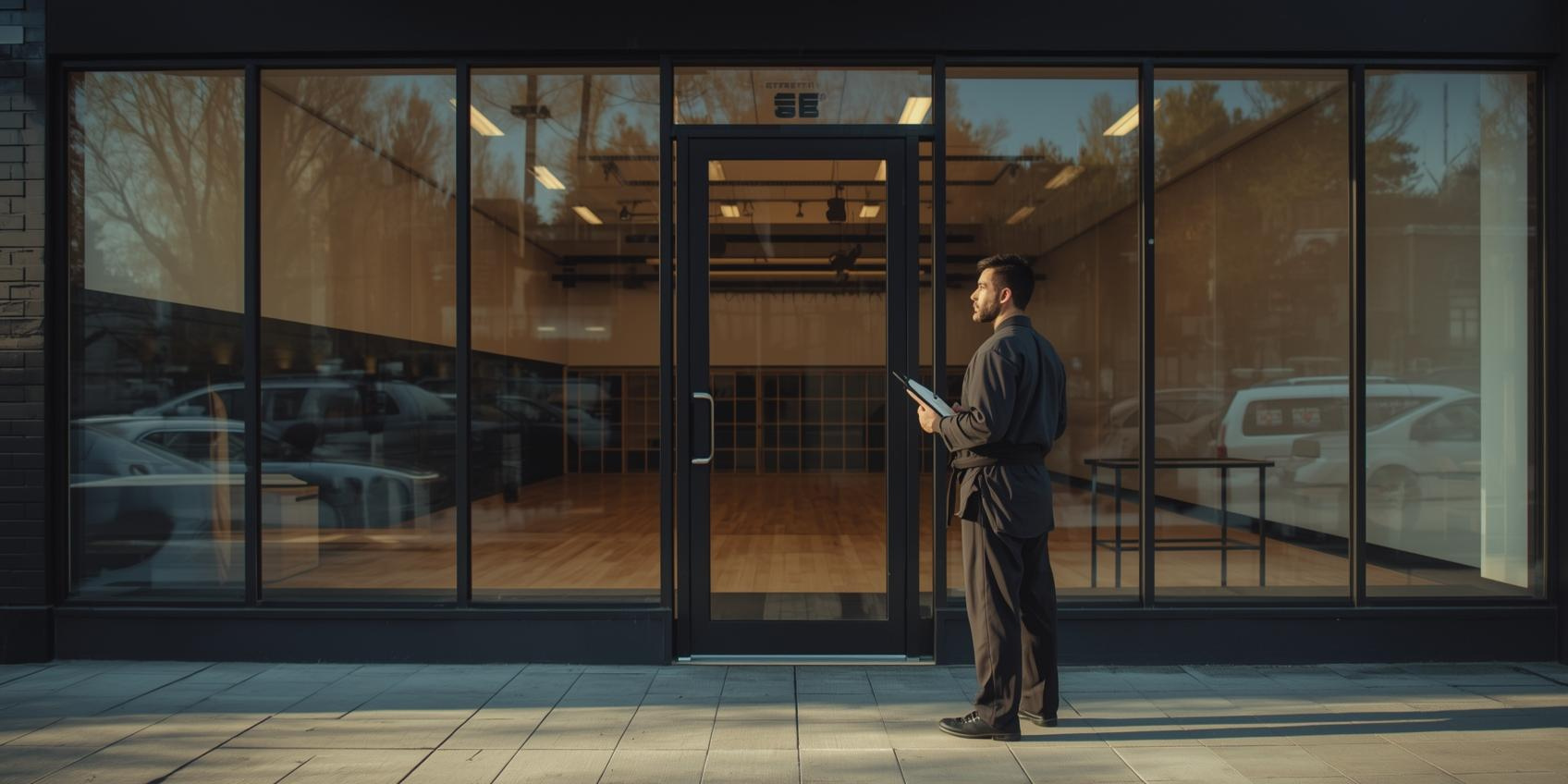
If you’re asking, “What should I do before signing a lease for my new martial arts school?” — you’re already thinking like a business owner. Many instructors rush this step because they’re eager to get the doors open. But signing the wrong lease can cost you thousands, create endless stress, and put your dream at risk before your first class ever runs.
I’ve seen it happen too often — instructors fall in love with a space, sign too fast, and discover later that it was the biggest mistake of their career.
“You don’t make money on the day you sign the lease — you lose it if you don’t read the fine print.”
A few years ago, I worked with an instructor named Carlos. He’d been teaching for over a decade and was finally ready to open his own school. He found what looked like the perfect space — bright, open, and full of potential. The landlord pressured him to sign quickly, and he did.
Six months later, that dream space became a financial burden. Parking was limited, neighbors complained about noise, rent increased because of a hidden clause, and city permits required costly upgrades.
Carlos told me later, “Rocky, I wish I had slowed down before signing that lease.”
Stories like his are far too common — and entirely avoidable with the right plan.
Before you fall in love with a location, define your long-term goals. What programs will you offer in five years — after-school classes, adult fitness, or competitive teams? Each requires different layouts, equipment, and parking needs.
I once worked with a client, Maria, who opened a 1,500-square-foot studio that seemed perfect. Within two years, her growing programs pushed her over capacity. She had to relocate — costing time, money, and momentum.
Ask yourself:
How many students do I expect in year one? Year five?
Will I need separate training areas or classrooms?
Is parking safe and sufficient?
Can parents easily see signage from the street?
Walk the space as if you’re a parent dropping off your child. If it doesn’t feel safe, convenient, and professional, it won’t feel that way to your students either.
Even the best space fails without demand. Social media ads are a quick, low-cost way to gauge community interest before you sign.
I helped a client, John, run a small Facebook ad campaign targeting a 10-mile radius around a potential location. Within two weeks, 75 people pre-registered for updates — enough validation to move forward confidently.
Keep it simple: a clean photo, clear message, and strong call to action. The goal isn’t to fill classes yet — it’s to confirm there’s genuine interest in your area.
For more insight, check out [How to Attract Martial Arts Students Before Opening Your School].
Zoning and permits can make or break your opening timeline. Before signing a lease, confirm that your potential space is legally approved for martial arts instruction.
Start with your city or county planning department, and verify:
Zoning compliance: Ensure the property allows martial arts, fitness, or educational use.
Occupancy limits: Confirm how many students, parents, and staff can safely occupy the space.
Noise and parking ordinances: Some areas restrict amplified sound or require a minimum number of parking spaces.
Fire marshal inspection: Schedule a walk-through to confirm exits, sprinklers, alarms, and overall fire safety compliance.
Certificate of Occupancy (CO): Make sure the CO matches your intended use.
Change of Use or Change of Occupancy: If the previous tenant was retail, storage, or office, you may need a new classification before operating.
Licensing requirements: Verify all local business, health, and safety licenses required to open.
If renovations are needed, know exactly what’s involved. Will you need architectural drawings? Are bathrooms ADA-compliant? Who pays for build-out and upgrades — you or the landlord?
Whenever possible, look for a turnkey property — one previously used as a martial arts school, dance studio, or gym. It’s often faster and cheaper to bring up to code.
Your rent is just one part of the cost equation. Many new owners underestimate their total monthly expenses. Beyond rent, include:
Utilities and insurance
Security, cleaning, and maintenance
Build-out, flooring, and signage
Permits and inspections
Marketing and technology subscriptions
One of my clients thought his $2,500 lease was manageable. Once everything was added in, the real monthly cost was closer to $4,000. Seeing the full financial picture early prevents painful surprises and helps you set the right tuition pricing.
Neighborhoods change throughout the day. Visit the location during morning drop-offs, afternoon traffic, and evening classes.
What looks quiet at noon might be gridlocked by 5 PM. I once saw a perfect location ruined by delivery trucks blocking entrances during peak hours. These observations reveal hidden challenges before you commit.
Your school doesn’t exist in isolation. The surrounding businesses and demographics affect your success.
Spaces near daycares, family restaurants, and fitness studios create natural referral opportunities. In contrast, empty or mismatched neighbors make growth harder. One client’s school thrived simply because it was next to an after-school center — that synergy made all the difference.
A space can look beautiful and still function poorly. Consider how noise carries, where parents will sit, and how students enter and exit between classes.
I’ve seen schools install mats only to realize parents were blocking emergency exits. Plan your floor like you plan your curriculum — with flow, safety, and experience in mind.
Before committing, study your competition. Know their:
Class offerings and schedules
Pricing models
Target demographics
Online reviews
This helps you position your school effectively. I helped a BJJ instructor discover that most nearby schools focused on adult classes. He shifted toward youth programs — and filled his roster in months.
Never assume a lease is non-negotiable. Landlords expect negotiation — even from new business owners. Ask for:
Free rent during build-out
Tenant improvement allowances
Early termination and renewal flexibility
Signage rights and parking arrangements
One client secured three free months and a build-out credit for mats and mirrors, saving thousands in start-up costs.
Your first space won’t always be your forever space. Protect yourself with:
Sublease or assignment options
Renewal terms
Clear exit clauses
Planning for flexibility keeps you in control if your school grows faster than expected or the area changes.
Your systems and marketing should be ready before opening day. Build early excitement through pre-registration campaigns, referral incentives, and community partnerships.
At the same time, set up your software — billing, attendance, waivers, and communications. A smooth launch builds confidence and professionalism from day one.
Before signing anything, inspect the property thoroughly. Check for:
Plumbing or electrical issues
HVAC functionality
Floor and ceiling conditions
Signs of leaks or structural wear
Any problems should be addressed before your name is on the lease. Once you sign, those repairs could become your responsibility.
Opening your own dojo is exciting — but emotion clouds judgment. Landlords can sense enthusiasm and use it to their advantage. Treat every conversation as a business negotiation. The success of your future students and staff depends on disciplined decision-making.
No deal is better than a bad deal. If the rent is too high, the location feels unsafe, or the landlord refuses to negotiate, walk away. There’s always another opportunity. Patience beats regret every time.
How long should my first martial arts school lease be?
Three to five years is ideal. Avoid long-term commitments until your business model is proven.
What percentage of revenue should rent be?
Aim for 15–20% of your gross revenue.
Should I lease or buy first?
Leasing is smarter when starting out. It conserves capital and gives you flexibility.
How do I estimate my break-even point?
Add rent, utilities, insurance, and staffing. Divide by your average tuition rate — that’s your minimum student count.
What should I include in my build-out plan?
Mats, mirrors, parent viewing areas, storage, bathrooms, and office space. Prioritize safety and flow.
Can I negotiate lease terms as a new owner?
Absolutely. Landlords appreciate prepared, professional tenants.
How do I test demand before signing?
Run small Facebook or Instagram ad campaigns or collect interest through early registration forms.
Opening a martial arts school is one of the most rewarding journeys you’ll ever take — but your foundation starts long before you hang the first banner. By clarifying your vision, validating demand, budgeting accurately, inspecting thoroughly, and negotiating wisely, you’ll avoid costly mistakes and set your dojo up for lasting success.
Curious to see how this applies to your school?
👉 Click here to schedule a demo with Black Belt Membership Software — and start your journey with confidence.

Payments & Membership Growth Strategist, with Black Belt Membership
See how Black Belt Membership can assists you. To manager your growing martial arts business.